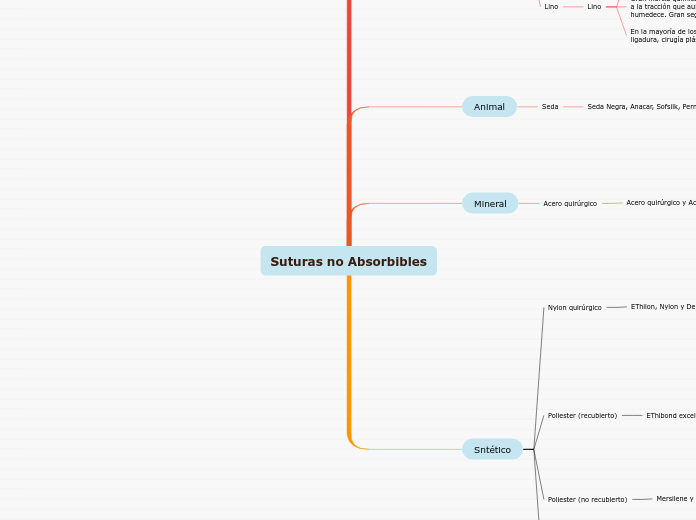por Adriana Paola Angeles Chavez 4 anos atrás
352
Suturas no Absorbibles

por Adriana Paola Angeles Chavez 4 anos atrás
352

Mais informações

To name your story, you have to think about the overall message and what you want your audience to understand from the story. Also, make it relevant and easy to remember.
El polipropileno tiene amplia aceptación en cirugía general, plástica, cardiovascular y ortopédica
Su anudado es más fácil y pasa bien a través de los tejidos.
Produce reacción tisular mínima y puede usarse en presencia de infección
Mantiene su fuerza tensil por tiempo indefinido
Es un polímero monofilamentoso muy resistente a la degradación enzimática
Uso en la aproximación y/o ligadura de tejidos blandos en general, incluyendo el uso en procedimientos cardiovasculares, oftálmicos y neurológicos
Sutura quirúrgica estéril, trenzada y no absorbible compuesta de Poli (tereftalato de etileno)
Están indicadas para su uso en aproximación general de tejidos blandos y/o ligadura, incluyendo el uso en tejido cardiovascular, oftalmológico y neural.
Máxima seguridad en la aproximación de tejidos en condiciones de estrés Soporte permanente (la resistencia a la tracción se retiene indefinidamente) Máxima seguridad con implantes protésicos
Compuestas de tereftalato de polietileno.
En 1 año sufre una degradación hidrolítica de 15 a 20%, con la correspondiente pérdida de fuerza tensil.
Produce una reacción tisular mínima y conserva bien su fuerza tensil
Sutura elástica y de gran fuerza tensil, pero en forma monofilamentosa tiene una propiedad llamada “memoria”
Resultante de la interacción de un ácido dicarboxílico y una diamina
The ending of a story is essential. We all know that if the ending is weak, what happened before loses its importance. So make it unpredictable, but fair. A resolved ending answers all the questions and ties up any loose threads from the plot.
This is the moment when the main character surpasses the last obstacle and finally faces their greatest challenge.
The climax usually follows one of these patterns:
Type in your answer.
No obstante, puede romperse en los puntos donde ha sido doblado o anudado, y también por fatiga del metal
Retiene indefinidamente su fuerza tensil cuando es utilizado correctamente; además, se comporta muy bien en presencia de infección
Aleación especial de hierro-níquel o hierro-cromo
The middle of the story is where you add layers of complications that will lead to the end. Reveal more about the character's journey. Did their personality go through changes? How did they overcome the challenges? And as you build up the story’s central conflict, make it more personal to that character. Also, from the middle act, you have to lead into the final act.
Your character(s) need(s) motivation in order to solve the challenge(s).
Why does your character need to confront this challenge? What does he/she expect to accomplish by solving it?
See a few examples:
ESTERILIZACIÓN EO (Oxido de etileno)
Las suturas trenzadas están disponibles recubiertas uniformemente con silicona o una mezcla especial de cera
RECUBRIMIENTO Cera de parafina y silicona
Suturas estériles y no mutagénicas compuestas de fibras de seda proteicas naturales llamadas fibroína
In the beginning of the story (or the exposition), you will need to introduce the setting and characters. You might also want to introduce the main conflict. This part of the story is important because it gives the reader necessary background information and maybe even a first insight into a character’s personality.
The setting (time & place) of a story can change throughout the plot.
The weather is an important element in your story because it can highly influence the ambiance and the mood of the characters.
En la mayoría de los tejidos corporales como sutura o ligadura, cirugía plástica, gastrointestinal y general.
The most affected character is the main character. Write down here if he/she is affected by these weather conditions in any way. For example, if they lost a family member or their home during a hurricane, etc.
Gran inercia química y biológica, elevada resistencia a la tracción que aumenta cuando el hilo se humedece. Gran seguridad en los nudos.
Decide if you want to include an element of nature in your story. For example, a rainbow can be a very nice choice for a happy ending. The mist in a story can represent mystery and secrets. A thunder can appear in the background at the moment when the 'bad guy' of the story makes its appearance, etc.
Composición: Fibras pericíclicas de tallo de "Linum Usitatissimun" parafinadas.
Does your story include catastrophic weather? See a few suggestions below or add your own:
- hurricane, earthquake, storm, etc
Characters are essential to a good story. Usually, the protagonist(s) is/are the most affected by the plot. Introduce a character by focusing on their actions, interests, and occupation, as the physical appearance doesn't make a difference in most cases.
Type in the name of your character.
El algodón pierde un 50% de la fuerza tensil a los 6 meses, pero conserva todavía el 30 ó 40% a los 2 años
Add other qualities/attributes of the character.
Aumenta su fuerza tensil si es humedecido antes de utilizarse.
What is your character's main goal?
El más débil de los materiales no absorbibles
Which traits best describe the character's personality? Choose more if necessary:
Fibra natural de celulosa
Choose the type of your chacter: